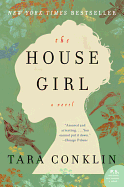
In her quietly stunning debut novel, which was #1 IndieNext pick in hardcover, Tara Conklin gives a name and a story to a figure who is both a vital figure and an overlooked cypher in the antebellum American South--the house girl. Usually a secondary character at best and set dressing at worst, portrayed as quiet and obedient or humorously sassy, in Conklin's hands the house girl becomes a strong, tragic and fully realized human being, one whose impact echoes down the future long after her life is over.
In 1852 Virginia, 17-year-old house slave Josephine looks after her dying mistress, Lu Anne Bell, while trying to dodge her master's fists. Although her last escape attempt ended in recapture, abuse and the stillbirth of her child, Josephine is ready to run away again. While she waits for her chance, she soothes half-mad Lu Anne by putting finishing touches on the paintings Lu Anne is no longer able to complete. A naturally gifted artist, Josephine's talent far surpasses Lu Anne's, but her world has no place for a slave with aspirations beyond manual labor. Still, even if she is destined to struggle for her very freedom, Josephine's gift sustains her spirit, "for she is an artist with the untethered eye of an artist and everywhere beauty lies down at her feet."
In 2004 New York, ambitious young attorney Lina Sparrow is assigned to a landmark slavery reparations case. If she succeeds in building a credible case, she could be in line to make partner, but her supervisor's indifference to her ideas and a backstabbing coworker hamper her efforts. Then, through friends of her artist father, Lina learns of rumors that the celebrated Southern artist Lu Ann Bell's paintings may have been the work of Josephine, a house slave whose fate is lost to history. If Lina can find a descendant of Josephine to act as plaintiff, their case will have the perfect public face, but first Lina must do the near-impossible: solve the mystery of what happened to Josephine more than 150 years ago. Complicating matters is Lina's father's sudden desire to speak about Lina's deceased mother after long years of silence. Now that the answers to all her questions about her family are within her grasp, Lina suddenly fears what she will learn about her brilliant, stifled mother.
Alternating between Josephine and Lina's points of view, Conklin draws two distinct portraits that intersect in surprising ways. While Josephine is buoyed by art, it shapes Lina's life in other ways. As the daughter of two artists, she has a creative sensibility, especially when she ruminates on "evoked flashes of her mother and early childhood that seemed cast in butter, soft and dreamy, lovely, rich." However, her mother Grace's death and her father Oscar's obscurity have forced Lina to focus on practicality from a young age.
Conklin's former life as a litigator for a major corporate law firm shows in her depiction of a young female lawyer trying to break through her firm's glass ceiling without sacrificing her ethics, the details spot-on, from Lina's dismissive, fame-hungry boss and deceptively friendly colleague Garrison--"sharp as one of Oscar's palette knives"--to her exhaustive research into Josephine's life. While initially motivated by her career, Lina quickly becomes engrossed in the subject matter: "Two hundred and fifty years of nameless, faceless, forgotten individuals....Where was the monument? Where was the museum? What had they wished for and worked for and loved?" Her investigation of slave narratives brings home to Lina a truth she had known but not fully understood, that in the case of slavery, "The harm was everyone and everywhere.... The harm is immeasurable." Lina's work is done in the name of seeking reparations for the descendents of slaves, but her discoveries remind the reader that no amount of reparation can ever undo the injury done to so many for so long.
While Conklin's overt topic is the slavery of African Americans, the story is at the same time an exploration of the feminine experience with forms of slavery both official and more subtle. Josephine's mistress may represent the white slave-owning class, but she herself is bound by her marriage to a place and life she wishes she hadn't chosen. Lina's mother, while born in a time of greater freedom for women, found herself similarly trapped by the demands of marriage and motherhood with no good escape route. Foremost, of course, are the two main characters and their very different struggles for freedom. Josephine seeks physical freedom by risking her life to run from her master. In a supposedly liberated future, Lina chooses to work a grueling schedule as her supervisor takes advantage of her ambition without rewarding her industry, a vague echo of Josephine's slavery. Readers will yearn for both women to throw off their shackles, whether literal or self-imposed. Skillfully executed and packed with surprises, this story of the ways in which art saves our humanity is an engrossing, do-not-miss adventure. --Jaclyn Fulwood

